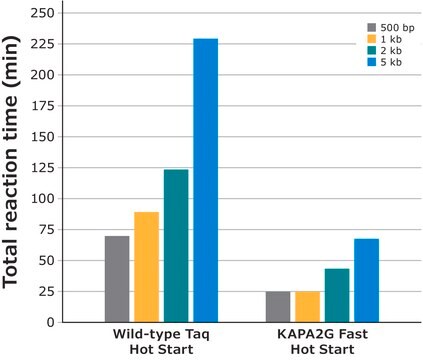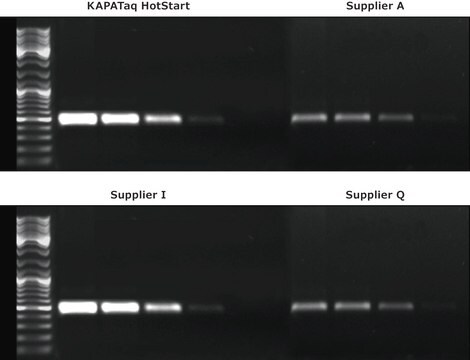2GFNTKB
Roche
KAPA2G Fast PCR Kit
with dNTPs
Synonyme(s) :
PCR, PCR kit
About This Item
Produits recommandés
Niveau de qualité
Utilisation
sufficient for 500 reactions
Durée de conservation
≤18 mo.
Caractéristiques
Fast PCR
Multiplex PCR
dNTPs included
hotstart: no
Conditionnement
pkg of 100 U (KK5008)
pkg of 250 U (KK5009)
Fabricant/nom de marque
Roche
Technique(s)
PCR: suitable
Entrée
purified DNA
Température de stockage
−20°C
Vous recherchez des produits similaires ? Visite Guide de comparaison des produits
Description générale
KAPA2G Fast DNA Polymerase Kits are designed for fast PCR, in which total reaction times are 20–70% shorter than those of conventional PCR assays performed with wild-type Taq DNA polymerase. This can be achieved without sacrificing reaction performance, and does not require specialized PCR consumables or thermocyclers.
Application
- PCR with confronting 2 -pair primers assay (PCR-CTPP)
- Routine PCR
- Fast PCR
- Genotyping
Actions biochimiques/physiologiques
Caractéristiques et avantages
- Extension times as low as 1 sec per kilobase
- Broad coverage of both AT- and GC-rich targets
High speed, higher performance :
- Single copy sensitivity from complex targets
- Increased yields
Quick Notes :
- KAPA2G Fast PCR Kits with dNTPs contain the engineered KAPA2G Fast DNA Polymerase, developed for fast PCR.
- Use 1 sec extension time for amplicons <1 kb and 15 sec/kb for longer amplicons, and save 20–70% of total reaction time.
- No need for specialized instrumentation or PCR consumables.
- Optimized buffer system offers improved yields, specificity and sensitivity, facilitating efficient primer annealing across a wide range of primer lengths, GC contents, and melting temperatures.
- Use 0.5 U KAPA2G Fast DNA Polymerase per 25 μL reaction, or less for smaller volumes.
- For high reaction efficiency, do not exceed 25 μL reaction volumes.
- KAPA2G Buffer A contains 1.5 mM MgCl2 at 1X.
- Reaction products are 3′-dA-tailed and may be cloned into TA cloning vectors.
Qualité
Notes préparatoires
Autres remarques
Composants de kit seuls
- KAPA2G Fast Standard or HotStart® DNA Polymerase (5 U/μL)
- 5X KAPA2G Buffer A with MgCl2
- MgCl2 25 mM
Mention d'avertissement
Warning
Mentions de danger
Conseils de prudence
Classification des risques
Acute Tox. 4 Oral - Aquatic Chronic 3 - STOT SE 2
Code de la classe de stockage
12 - Non Combustible Liquids
Classe de danger pour l'eau (WGK)
WGK 1
Point d'éclair (°F)
does not flash
Point d'éclair (°C)
does not flash
Certificats d'analyse (COA)
Recherchez un Certificats d'analyse (COA) en saisissant le numéro de lot du produit. Les numéros de lot figurent sur l'étiquette du produit après les mots "Lot" ou "Batch".
Déjà en possession de ce produit ?
Retrouvez la documentation relative aux produits que vous avez récemment achetés dans la Bibliothèque de documents.
Les clients ont également consulté
Articles
An overview of directed evolution and the methods for generating proteins with optimized or entirely new functions.
Notre équipe de scientifiques dispose d'une expérience dans tous les secteurs de la recherche, notamment en sciences de la vie, science des matériaux, synthèse chimique, chromatographie, analyse et dans de nombreux autres domaines..
Contacter notre Service technique








